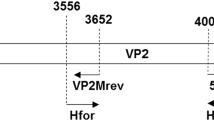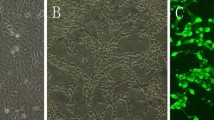ABSTRACT
Canine parvovirus (CPV) was first recognized in the late 1970 s in dogs and has mutated and spread throughout the world in canid and felid species since then. In this study, a novel CPV was isolated from the endangered red panda (Ailurus fulgens) in China. Nucleotide and phylogenetic analysis of the capsid protein VP2 gene classified the red panda parvovirus (RPPV) as a CPV-2a type. Substitution of Val for Gly at the conserved 300 residue in RPPV presents an unusual variation in the CPV-2a amino acid sequence and is further evidence for the continuing evolution of the virus. The 300 residue is important in distinguishing the antigenicity and host range of CPVs. The clinical significance and population impact of RPPV infection in captive red pandas in China is unknown and is an important topic for future research.

Similar content being viewed by others
References
M.J. Appel, B.J. Cooper, H. Greisen, L.E. Carmichael, J. Am. Vet. Med. Assoc. 173, 1516 (1978)
C.R. Parrish, C.F. Aquadro, M.L. Strassheim, J.F. Evermann, J.-Y. Sgro, H.O. Mohammed, J Virol 65, 6544 (1991)
U. Truyen, A. Gruenberg, S.-F. Chang, B. Obermaier, P. Veijalainen, C.R. Parrish, J. Virol. 69, 4702 (1995)
Y. Ikeda, M. Mochizuki, R. Naito, K. Nakamura, T. Miyazawa, T. Mikami, E. Takahashi, Virology 278, 13 (2000)
M.S. Roberts, J.L. Gittleman, Mamm. Species 222, 1 (1984)
F.W. Wei, Z.J. Feng, Z.W. Wang, J.C. Hu, Biol. Cons. 89, 285 (1999)
S. Kumar, K. Tamura, M. Nei, Brief Bioinform. 5, 150 (2004)
M. Nei, S. Kumar, Molecular Evolution and Phylogenetics, Oxford University Press (2000)
R.V. Pollock, L.E. Carmichael, Cornell Vet. 72, 16 (1982)
C.R. Parrish, C.F. Aquadro, L.E. Carmichael, Virology 166, 293–307 (1988)
Acknowledgements
We appreciate the permission from the Beijing Zoo and the Kunming Wildlife Park to collect the samples from their red pandas. Thanks also to the Chinese National Disease Laboratory for supplying the reference strain of CPV. Sincere gratitude to Drs. Edward Dubovi and Colin Parrish for their ideas in helping to interpret the results of this study. Funding for this study came from the Wildlife Infectious Disease Project of the Institute of Zoology, Chinese Academy of Sciences, the Chinese State Forestry Administration and the American Association for the Advancement of Science.
Author information
Authors and Affiliations
Corresponding author
Rights and permissions
About this article
Cite this article
Qin, Q., Loeffler, I.K., Li, M. et al. Sequence analysis of a canine parvovirus isolated from a red panda (Ailurus fulgens) in China. Virus Genes 34, 299–302 (2007). https://doi.org/10.1007/s11262-006-0023-6
Received:
Accepted:
Published:
Issue Date:
DOI: https://doi.org/10.1007/s11262-006-0023-6




